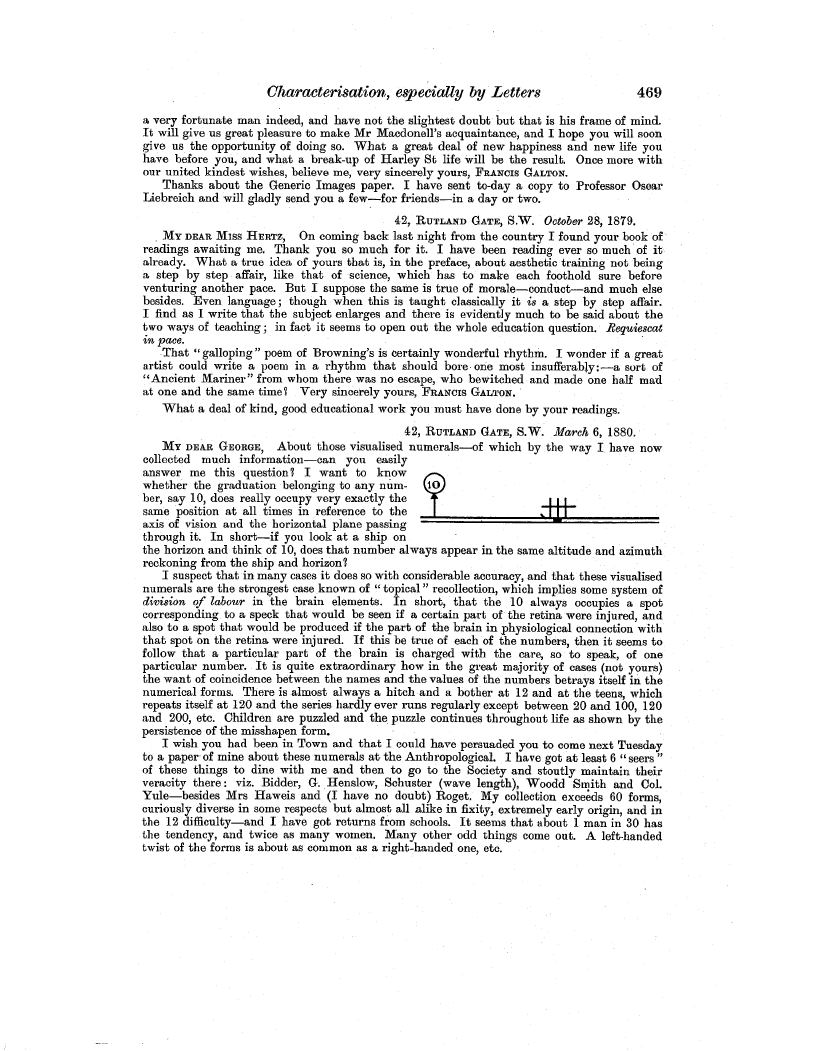| ||||||

OCR Rendition - approximate
Characterisation,, especially by Letters 469 a very fortunate man indeed, and have not the slightest doubt but that is his frame of mind. It will give us great pleasure to make Mr Macdonell's acquaintance, and I hope you will soon give us the opportunity of doing so. What a great deal of new happiness and new life you have before you, and what a break-up of Harley St life will be the result. Once more with our united kindest wishes, believe me, very sincerely yours, FRANCIS GALTON. Thanks about the Generic Images paper. I have sent to-day a copy to Professor Osoar Liebreich and will gladly send you a few-for friends-in a day or two. 42, RUTLAND GATE, S.W. October 28, 1879. MY DEAR MISS HERTZ, On coming back last night from the country I found your book of readings awaiting me. Thank you so much for it. I have been reading ever so much of it already. What a true idea of yours that is, in the preface, about aesthetic training not being a step by step affair, like that of science, which has to make each foothold sure before venturing another pace. But I suppose the same is true of morale-conduct-and much else besides. Even language; though when this is taught classically it is a step by step affair. I find as I write that the subject enlarges and there is evidently much to be said about the two ways of teaching; in fact it seems to open out the whole education question. Requiescat in pace. That "galloping" poem of Browning's is certainly wonderful rhythm. I wonder if a great artist could write a poem in a rhythm that should bore one most insufferably:-a sort of "Ancient Mariner" from whom there was no escape, who bewitched and made one half mad at one and the same time? Very sincerely yours, FRANCIS GALTON. What a deal of kind, good educational work you must have done by your readings. 42, RUTLAND GATE, S.W. March 6, 1880. MY DEAR GEORGE, About those visualised numerals--of which by the way I. have now collected much information-can you easily answer me this question? I want to know whether the graduation belonging to any num ber, say 10, does really occupy very exactly the same position at all times in reference to the axis of vision and the horizontal plane passing through it. In short-if you look at a ship on the horizon and think of 10, does that number always appear in the same altitude and azimuth reckoning from the ship and horizon? I suspect that in many cases it does so with considerable accuracy, and that these visualised numerals are the strongest case known of " topical " recollection, which implies some system of division of labour in the brain elements. In short, that the 10 always occupies a spot corresponding to a speck that would be seen if a certain part of the retina were injured, and also to a spot that would be produced if the part of the brain in physiological connection with that spot on the retinaa were injured. If this be true of each of the numbers, then it seems to follow that a particular part of the brain is charged with the care, so to speak, of one particular number. It is quite extraordinary how in the great majority of cases (not yours) the want of coincidence between the names and the values of the numbers betrays itself in the numerical forms. There is almost always a hitch and a bother at 12 and at the teens, which repeats itself at 120 and the series hardly ever runs regularly except between 20 and 100, 120 and 200, etc. Children are puzzled and the puzzle continues throughout life as shown by the persistence of the misshapen form. I wish you had been in Town and that I could have persuaded you to come next Tuesday to a paper of mine about these numerals at the Anthropological. I have got at least 6 "seers" of these things to dine with me and then to go to the Society and stoutly maintain their veracity there : viz. Bidder, G. Henslow, Schuster (wave length), Woodd Smith and Col. Yule-besides Mrs Haweis and (I have no doubt) Roget. My collection exceeds 60 forms, curiously diverse in some respects but almost all alike in fixity, extremely early origin, and in the 12 difficulty-and I have got returns from schools. It seems that about 1 man in 30 has the tendency, and twice as many women. Many other odd things come out. A left-handed twist of the forms is about as common as a right-handed one, etc.
|